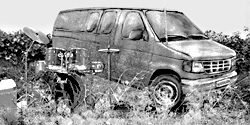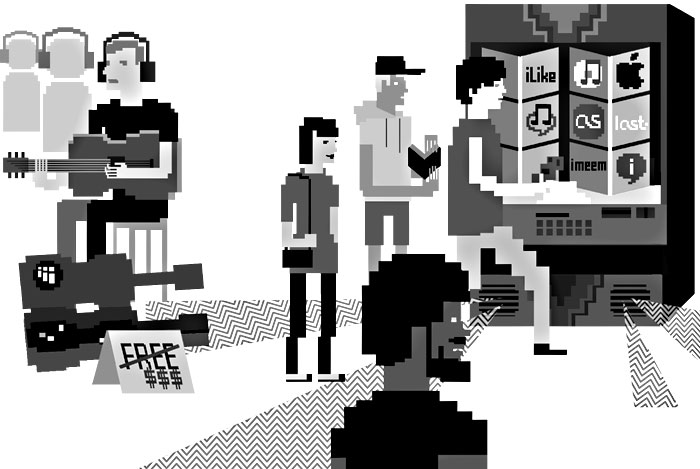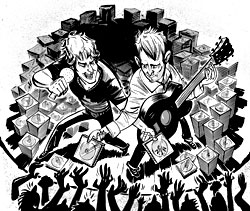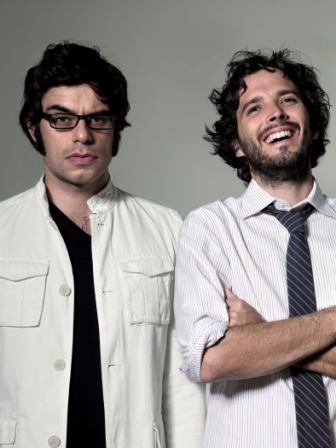Like truckers, salmon-jerky vendors, and drive-through liquor stores, musicians live and die by the road. As album sales continue to decline, schlepping an old drum set to Tallahassee in the back of a 1992 Ford Econoline van remains one of the last main revenue streams for bands.
Last week, the average price for a gallon of gas in the United States hit a record $3.33. The new high of $4.06 for a gallon of diesel has caused truckers to slow down to increase gas mileage. Salmon-jerky and liquor vendors are obviously still in the black, but musicians have increasingly found themselves caught in a tug-of-war between the lure of the road and rising gas prices.
After a brief tour in Alaska that nearly wiped him out financially, my friend Nick Jaina is on the road—coast-to-coast for two months—yet again. When I speak to him via phone, he tells me he’s no longer driving the same gas-sucking truck. Yet the question remains: is the Portland singer/songwriter insane? This is not the kind of question one can ask directly; it’s the kind that gets turned into a poll answered by 90 people in the music industry, probing the underlying truths about musicians, touring, and the cost of fuel.
“To be honest, I haven’t really thought about it. The touring industry is still strong,” says Brian McFadin, the Showbox’s booking agent, responding to my e-mail questionnaire; Chop Suey’s Pete Greenberg also said he was still busy. As it turns out, not only are the bands playing those particular venues often able to afford the help of booking agents and tour managers in assessing profits, they are also assured of playing to healthy-sized audiences.
But despite the reliable income, their expenses are still rising. “Those people have costs to think about, too—it costs a lot of money to fill up a jet,” says Jeremy Hadley of Invisible City Booking, which handles Northwest-based acts like Velella Velella and Laura Gibson. The trend among bigger-name acts seems to be streamlining their performances: fewer dancers or backup musicians, more light shows. Serj Tankian, formerly of System of a Down, recently commented that he wanted to “look into holographic touring.”
But smaller bands are lightening their loads too. Brian Foss, who books shows at the Funhouse, has noticed a significant change in his business: “There have been less bands touring, and more bands requesting guarantees.” Those who are touring are taking fewer musicians and gear. Some singer-songwriters have replaced their friends with machines, playing more solo shows and arriving via Greyhound or Amtrak. Others, like the Oakland-based punk trio XBXRX, have cut back on the size or amount of their gear to increase gas mileage: “We have gone from van to minivan to car over our 10-year career,” says guitarist Steve Touchton. Multi-instrumentalist Paul Austin of the Transmissionary Six (playing at the High Dive on April 5) says they’ve “developed two versions of the band: a full band that rocks out, and a trio…The latter fits in a car.” Coulter Leslie halved the size of his band for a recent tour, dumping the ubiquitous “van full of gear and guys” for a car and saving an estimated $4,000 in gas. While venues in Europe typically supply the backline, or gear, more venues in the U.S.—or bands on the same bill—are willing to loan things like amps or drums if it’s discussed in advance.
Streamlining also means cutting out less-populated areas of the country. Even though many musicians report that music-starved small towns can make for bigger, more appreciative audiences, many say it’s not worth the gamble. It also means cutting out big shows if they’re too far away. Kerry Zettel, vocalist and bassist for Das Llamas, says that the band—among others polled—had to pass up this year’s SXSW “because the round trip would have cost just over a grand.” Bands typically justify such distances with proper planning, playing shows at every possible stop. That trend has been exacerbated, forcing musicians to maintain calendars normally befitting type-A executives. On her current tour, Camille Bloom—who plays Columbia City Theater on April 5—is playing 14 shows in a 12-day stretch.
Despite the rising costs of plane fuel (and consequently plane tickets), sometimes ditching the car is easier. It can be a one-off: Seattle’s spiritually-oriented musician Stefan Mitchell finds it’s cheaper to fly to San Francisco than drive to Portland. Others fly to avoid the “dead zone,” the venue-light area between the West Coast and Chicago. John Ewing, drummer for the local jazz ensemble Reptet, says his band (which began a three-week tour on April 2) rearranged some dates after realizing they’d “save a lot of money by flying into Chicago, playing there, then renting a van and driving the rest of the way out to New York.” Others swear by ditching as much as you can—bandmates and gear—and flying, reasoning that a decent, profitable one-man show in New York is better than a money-sucking drive with friends.
A few musicians have invested in hybrids, but some avoid regular fuel altogether. Jack Johnson’s trucks for his 2008 tour are all biodiesel. Some bands have found eco-mechanics to switch their cars to biodiesel for free. While bassist Michael Troutman from New York’s Awesome Color agrees that biodiesel seems “pretty promising,” he notes “I can’t imagine there’s enough french-fry grease for every band that wants to tour to be doing that.”
Bands like the Ditty Bops, Jeremy Fisher, and Blind Pilot have toured via bicycle. “You eat a lot more, but it still isn’t nearly as expensive as gas,” says Ryan Dobrowski, drummer for Portland’s Blind Pilot. The Austin, Texas, indie outfit Peter and the Wolf famously toured the West Coast via sailboat in the summer of 2006. Such efforts can make up for a lack of gigs in cities, with their glut of built-in publicity—even of the bad sort. Last year, Portland folkster Jon Crocker’s walking tour from Arlington, Va., to Brooklyn, N.Y., was cut short after developing tendinitis in both his Achilles tendons.
Yet for most, buying fuel can’t be avoided, and the rising costs aren’t easily offset by other revenue. Pay from venues has remained relatively stagnant over the past decade. “$100 to fill your tank!! This is tough when the ticket prices and guarantees stay the same,” says the Blakes’ vocalist and guitarist Garnet Keim. Fans accustomed to the 99¢-per-song cost model balk at the price of CDs sold at shows. Merch sales help, though decreasingly in a singles-driven industry in which a Vampire Weekend T-shirt is dated the minute you leave the show.
Even though all bands spoke of the benefits of touring in ecstatic, religious terms, succeeding on the road “has nothing to do with art,” says Hadley. “It’s who’s making the most money and setting it up well enough to make it financially viable. Bands fare best when they look at touring as an investment…but it’s just not going to pay off for everybody.” True to his point, the answers I received from seasoned musicians actually turning a profit on the road gave the impression that accountants, rather than artists, were on tour. When gas prices force bands to think like accountants first and musicians second—and scare away those unable to do so immediately—those left behind may be the artists whose voices we need to hear most.








